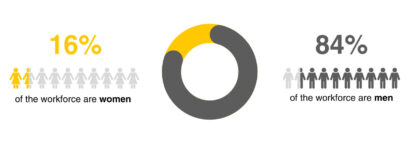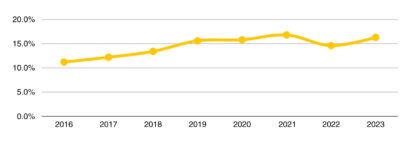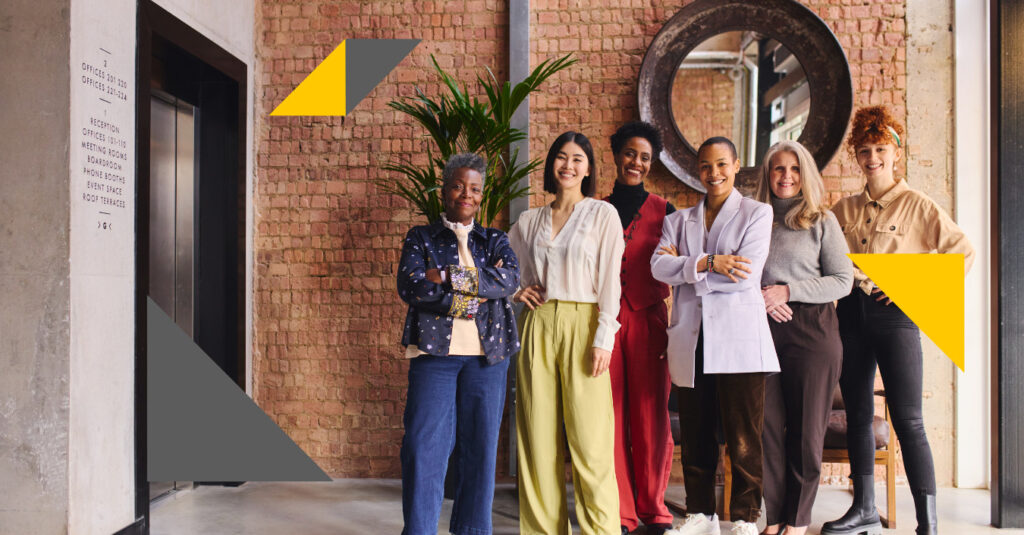We all know that rail is a male-dominated workforce. The sector has been taking many different steps and implementing a range of initiatives to broaden the demographic profile of the workforce, including women. However, it is clear that challenges remain and there is more to be done.
In this article, we use NSAR Rail Workforce Survey[1] 2023 data to form a snapshot of women working in rail – looking at what proportion of the workforce are women, what types of work they do and their concentration in senior leadership.

Figure 1
The proportion of women in the rail workforce is 16.3%, as illustrated in Figure 1. This figure has steadily increased since the inception of the NSAR Rail Workforce Survey (in 2016) and, despite a dip in 2022, the numbers are showing a positive upward trend, as shown in Figure 2. Since 2016, the proportion of women in rail has increased by over 5 percentage points.

Figure 2
Asset type by gender
It is easier to target recruitment efforts when demographics are known. Using the Rail Workforce Survey data, we have investigated the gender proportions in different asset types and skill levels across the rail workforce to help employers with their recruitment strategies.

Figure 3
Each job role fits within an asset type. Figure 3 compares asset type to gender. It shows women have the highest profile in the asset type of Business Management, which includes corporate support functions such as HR, finance and administrative roles. Operations and Property, Stations & Depots have the next highest proportions. These asset types have a higher number of customer-facing roles.
At the other end of the scale, Electrification & Plant and Civils & Structures have less than 10% of the employees categorised as women. These figures indicate that these asset types would be ideal places to start increasing the number of women in the workforce, especially because they have a high people need compared to other asset types.
Women in leadership
Sector leaders are aware of the need to increase the proportion of women in senior roles. Currently, just 8.5% of women are in Skill Level 6 (senior) or Skill Level 7 (executive) roles, compared to 11% of men.
It is useful to understand which areas and roles women are excelling in. Business Management has the highest proportion of women and the highest proportion in senior roles. The Operations asset type, which includes back office and support roles like HR and payroll, has the second-highest proportion of women but the lowest numbers in senior roles.

Figure 4
Rail must create a diverse and inclusive workforce to reflect the communities it serves and ensure equity of opportunity for current and future employees. Broadening the range of diverse skill sets is crucial if the rail sector is to be attractive to different types of people and competitive with other industries. Diversity has been proven to improve productivity.
The industry should persist in providing opportunities to increase the number of women in the workforce. While numbers are trending in the right direction, there is more to do. Continued implementation of strategies such as job-shares, increased opportunities for part-time working and increased role flexibility are evidence that the sector is attempting to adapt and attract from a different resource pool.
Other opportunities to increase diversity include using open and fair recruitment policies to attract candidates from the widest pool, such as blind CV screening and diverse interview panels. Building a culture of inclusion and respect by developing policies on equality, diversity and inclusion (EDI) is also important.
[1] The NSAR Rail Workforce Survey is an annual comprehensive survey of rail industry professionals, profiling approximately 95% of the workforce including the supply chain.

